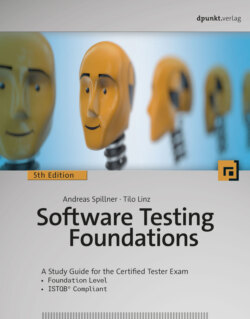Читать книгу Software Testing Foundations - Andreas Spillner - Страница 14
2.1.3 Test Artifacts and the Relationships Between Them
ОглавлениеThe previous sections have already described some types of test artifacts. The following sections provide an overview of the types of artifacts necessary to perform dynamic testing.
Test basis
The test basis is the cornerstone of the testing process. As previously noted, the test basis comprises all documents that help us to decide whether a failure has occurred during testing. In other words, the test basis defines the expected behavior of the test object. Common sense and specialist knowledge can also be seen as part of the test basis and can be used to reach a decision. In most cases a requirements document, a specification, or a user story is available, which serves as a test basis.
Test cases and test runs
The test basis is used to define test cases, and a test run takes place when the test object is fed with appropriate test data and executed on a computer. The results of the test run are checked and the team decides whether a failure has occurred—i.e., whether there is a discrepancy between the test object’s expected and actual behaviors. Usually, certain preconditions have to be met in order to run a test case—for example, the corresponding database has to be available and filled with suitable data.
Test conditions
An individual test cannot be used to test the entire test basis, so it has to focus on a specific aspect. Test conditions are therefore extrapolated from the test basis in order to pursue specific test objectives (see above). A test condition can be checked using one or more tests and can be a function, a transaction, a quality attribute, or a structural element of a component or system. Examples of test conditions in our case study VSR-II system are vehicle configuration permutations (see section 5.1.5), the look and feel of the user interface, or the system’s response time.
Test item
By the same token, a test object can rarely be tested as a complete object in its own right. Usually, we need to identify separate items that are then tested using individual test cases. For example, the test item for VSR-II’s price calculation test condition is the calculate_price() method (see section 5.1.1). The corresponding test cases are specified using appropriate testing techniques (see Chapter 5).
Test suites and test execution schedules
It makes little sense to perform test cases individually. Test cases are usually combined in test suites that are executed in a test cycle. The timing of test cycles is defined in the test execution schedule.
Test scripts
Test suites are automated using scripts that contain the test sequence and all of the actions required to create the necessary preconditions for testing, and to clean up once testing is completed. If you execute tests manually, the same information has to be made available for the manual tester.
Test logs
Test runs are logged and recorded in a test summary report.
Test plan
For every test object, you need to create a test plan that defines everything you need to conduct your tests (see section 6.2.1). This includes your choice of test objects and testing techniques, the definition of the test objectives and reporting scheme, and the coordination of all test-related activities.
Figure 2-2 shows the relationships between the various artifacts involved. Defining the individual activities involved in the testing process (see section 2.3) helps to clarify when each artifact is created.
Fig. 2-2 The relationships between test artifacts
